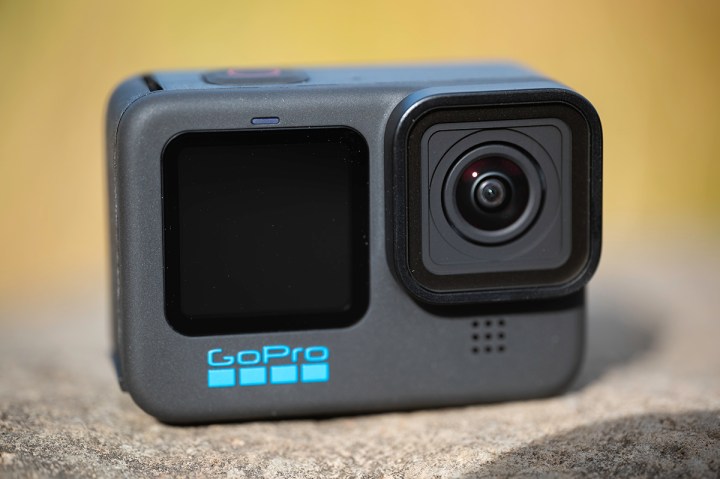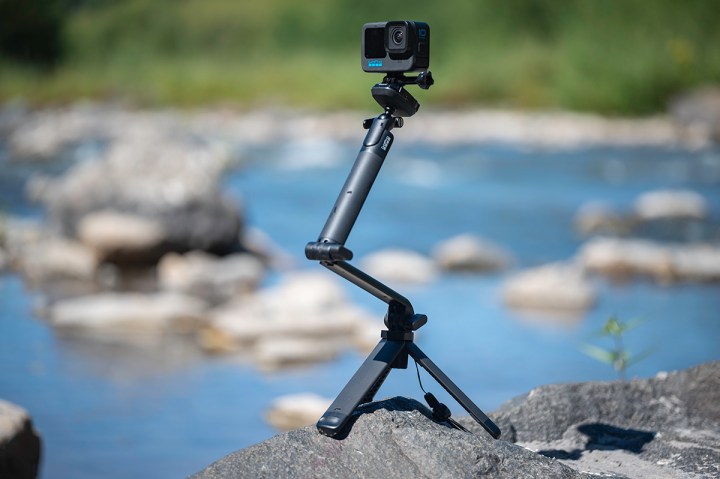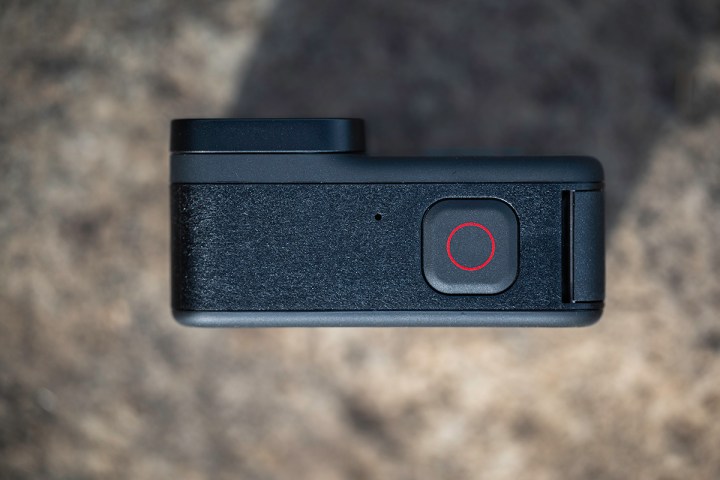
GoPro Hero 10 Black Review: An excellent evolution
MSRP $499.00

“Don’t judge a camera by its housing, this new hero is full of hidden talents.”
Pros
- 5.3K 60 fps video capture
- Upgraded stabilization
- Automatic cloud storage integration
- 2.7k 240 fps slow motion
- Touchscreen Interface is remarkably useable in wet conditions
Cons
- Image quality and stabilization degrade significantly in low light
- Short battery life
Often challenged but never conquered, GoPro has ruled the action camera scene for as long as it has existed. The GoPro Hero 10 Black shows just why this line of products has been so successful. I’ll just come right out and say that this is certainly the best action camera on the market right now, as well as the greatest action camera ever.
If you’re going to buy a new action camera, this is almost certainly the one you should get, so the question here really is whether or not existing GoPro owners of the Hero 9, or even the Hero 8, will find the tenth generation a compelling upgrade.
Design
This is actually a good thing, though, as I don’t see how it could be improved upon, and it enables the Hero 10 Black to be compatible with all the accessories that worked with its predecessor. That includes things like the GoPro Media Mod and the Max lens mod, though compatibility with the latter will have to wait for the firmware update scheduled for November 16, 2021.

Despite its similar appearance, the lens cover of the Hero 10 has actually received a few rather significant upgrades that I really appreciated. The glass now has a hydrophobic, water-shedding coating that made for much clearer shots when I took the camera swimming, and it’s more scratch-resistant and less prone to ghosting.
I’ve got to give major kudos to GoPro for its packaging, which is plastic-free and features a rather nice travel case. It’s clear that a lot of thought went into reducing waste, which is both good for the environment and saves you from having to dispose of a mountain of unnecessary garbage.

Performance
With any camera, the most crucial factor lies in the quality of its images and/or video. In most ways, the Hero 10 knocks it out of the park in this regard. The boost in image quality enjoyed by the Hero 10 comes from its new GP2 processor, which enables it to take full advantage of its 23MP sensor. In the Hero 9, still photo resolution was limited to 20MP, and video to 5K at 30 frames per second (fps). The Hero 10 can shoot full 23MP still photos and capture 5.3K video at up to 60 fps.
The Hero 10 knocks it out of the park in terms of image/video quality.
Though the resolution bump is, in practice, imperceptible, the 60 fps video capture is a major upgrade. It means that it’s now possible to do slow-motion at resolutions higher than 4K. It could well be debated if 5.3K is even useful to most videographers, but an important factor to consider is that if you’re shooting at 5.3K, you can pull 15.8MP stills from the video (19.6MP stills with 5K). I was quite pleased with these stills, and I found them to be a big step up from stills pulled from 4K video.
Of course, 5.3K is just the tip of the iceberg of the video capabilities of the Hero 10. For me, the most exciting aspect of this camera is the leap forward it represents for slow-motion video at lower resolutions.
Frame rate compared to the Hero 9 hasn’t just doubled up at 5K, but at 4K and 2.7K as well. That’s 120fps
It’s by far the best digital image stabilization I’ve ever used.
Another significant upgrade that solidified my love of the Hero 10 is the new Hypersmooth 4.0 video stabilization. It’s by far the best digital image stabilization I’ve ever used, and it truly did deliver results comparable to a mechanical gimbal in many circumstances. When riding a bike down a gravel road while holding the camera in my hand, I was able to capture usable footage without noticeable jitters from the rough ground.
Walking with the Hero 10 also produced steady results, though running on a bumpy trail through the forest proved to be a bit too much for it. The tilt limiter has increased from 27 degrees to 45 degrees, meaning that when this is enabled, the camera is more capable of keeping the horizon level.

Though the new, more powerful processor does improve performance in low light, there’s still no getting away from the laws of physics. Image quality falls off sharply in dim lighting conditions, though I will say that I found the results to be better than they are on some other cameras I’ve used that have similarly small-sized image sensors.
I was very impressed in terms of audio. The Hero 10 delivered usable recordings even during a windy bicycle ride on a busy road. It’s good enough that I fully plan to incorporate it into the production of my own videos.
I was very impressed in terms of audio.
I also have to give special mention to the time-lapse features present in the Hero 10. These include Hyperlapse and Nightlapse, in addition to the more traditional standard time laps. This is one of the things I use action cameras for the most. The small size and durable, waterproof characteristics of the Hero 10 make it the perfect device to leave out in the weather to capture long time lapses of changing weather or traffic on a city street.
Software
The onboard software on the Hero 10 is snappy and easy to operate using the touchscreen and mode select button. The new processor makes everything from boot-up to menu navigation faster, and the rear screen runs at higher frame rates, so the live view more closely matches the footage you are capturing.
The Hero 10 can also be controlled remotely through the Quik app, which also includes some very handy editing functions. I honestly found that I preferred some aspects of editing footage through this app on my phone over using Adobe Premiere on my PC.
Connectivity
I am very impressed by how seamless connecting my phone to the Hero 10 is. Just open the app and power on the camera, and the two connect automatically without any fuss once you’ve enabled all the permissions on your phone setup. This ease of use made me far more likely to use the app with the Hero 10. Most other camera companion apps are such a hassle when connecting devices that it isn’t worth the effort most of the time.
The Hero 10 takes it a step further, because with a GoPro subscription, you get free, unlimited cloud storage for photos and videos captured with the device, and the Hero 10 can do this automatically whenever it’s charging. Just connect the camera to your home Wi-Fi through the app, and you no longer have to think about pulling footage from your camera to your computer via USB (though you can do that instead if you prefer, or if you have a weak internet connection). Once in the cloud, and again assuming a strong internet connection, your footage can be quickly downloaded onto any device.
I was very impressed by how seamless connecting my phone to the Hero 10 was.
For me, this capability was more a tantalizing vision of the future rather than reality, since my home internet connection runs at around 10Mbps on a good day. For those with decent, modern broadband internet, the automatic cloud storage is a highly valuable feature.
Another feature worth noting is that the Hero 10 is now capable of livestreaming in 1080p with Hypersmooth enabled. The front display can be used for framing, which makes the Hero 10 a compelling option for various livestreaming applications.

Battery
When I first started using the Hero 10, I was kind of shocked by how quickly the battery drained. Just a short session with it burned through most of the juice, but it’s important to put this into the context of the device. I use action cameras to capture short clips, typically less than a minute long, and despite the battery having a remarkably short life, I never actually felt limited by it. Still, you’ll want to have a couple extra batteries to use with it, especially if you plan to shoot in 5.3K, or at high frame rates.
Price and availability
With an MSRP of $499, the GoPro Hero 10 Black initially seems quite steeply priced, especially considering that this is $50 more than the Hero 9 launched for a year ago. However, GoPro’s unique pricing model helps to bring this down significantly if you opt into a GoPro subscription. With the subscription included, the total cost is just $399, which is much easier to swallow, plus you get to enjoy all the benefits of the GoPro subscription for a year.
After your first year, that subscription will cost you $5 per month, or $50 per year, and for that price, I would personally consider it a bargain, particularly if you have an internet connection capable of handling automatic uploading of high-resolution footage. The subscription comes with other benefits, such as discounts and damaged camera replacement.
An accessory bundle is also available with the Hero 10 for $50 more, and includes a shorty tripod, magnetic swivel clip, extra battery, and 32GB microSD card.

Our take
The GoPro Hero 10 Black may look on the surface like a clone of its predecessor, but once you dig in under the hood, you will find that just about everything on this camera has seen a drastic upgrade. In an age where everyone carries a capable camera in the form of a smartphone, it’s difficult to design a compelling dedicated camera. The Hero 10 does this by being tough where your phone is fragile, and by incorporating a staggering degree of versatility so that it may lend itself to a vast range of different uses. Action may be where it shines, but the truth is that if you create videos of any kind, this is a tool that belongs in your kit.
Is there a better alternative?
No, there’s no camera like the Hero 10 that outperforms it. However, if you need something that fits into a smaller budget, the Hero 9 Black is available for $349, and the Hero 8 Black for just $279. Both are still great options, though I’d recommend the $200 DJI Osmo Action over the Hero 8. Alternatively, you could opt for a 360 camera like the GoPro Max or the Insta360 One X2.
How long will it last?
A new GoPro Hero is as much a staple of the fall season as pumpkin spice, but each new iteration remains a relevant and capable tool for many years. That’s, of course, dependent on how roughly you treat these rugged little cameras. However, if you do go with the GoPro subscription, you’ll be able to get a replacement (two per year) for a fraction of the cost of a new camera. With cameras designed to be put into harm’s way, that’s a major advantage.
Should you buy it?
If you’re in the market for a new action camera, this is the clear and obvious choice. For existing Hero camera owners, the huge boost to slow-motion capabilities may be alone make the upgrade worthwhile.
Credit : Source Post










